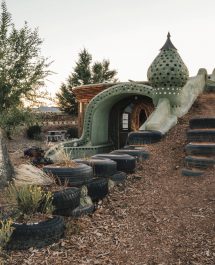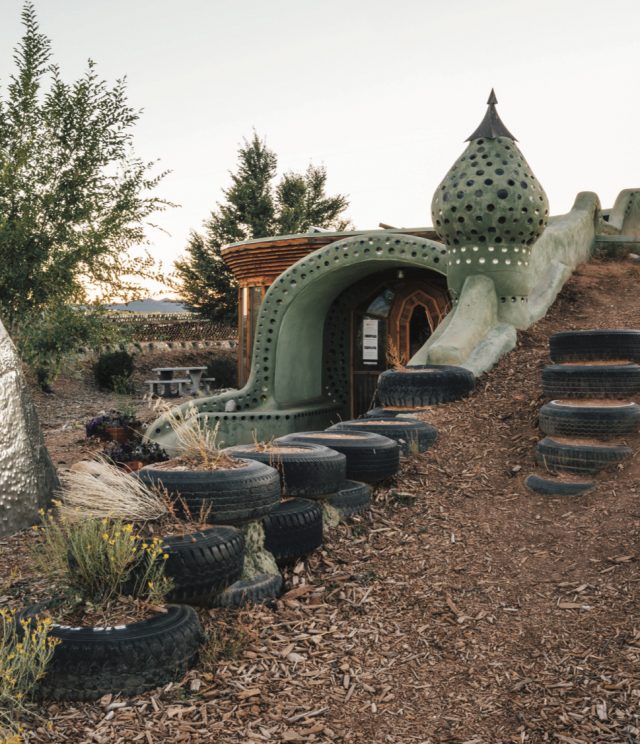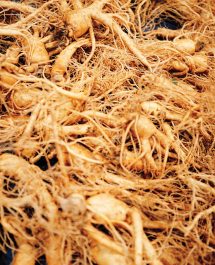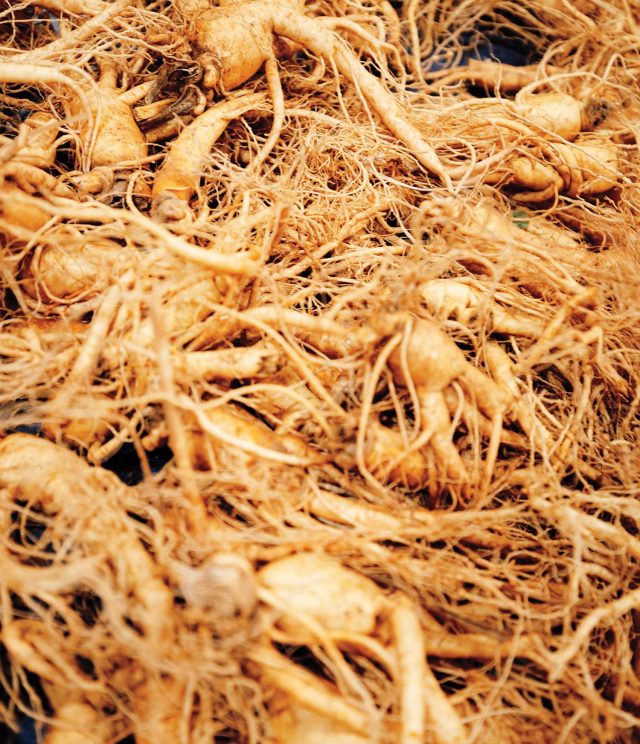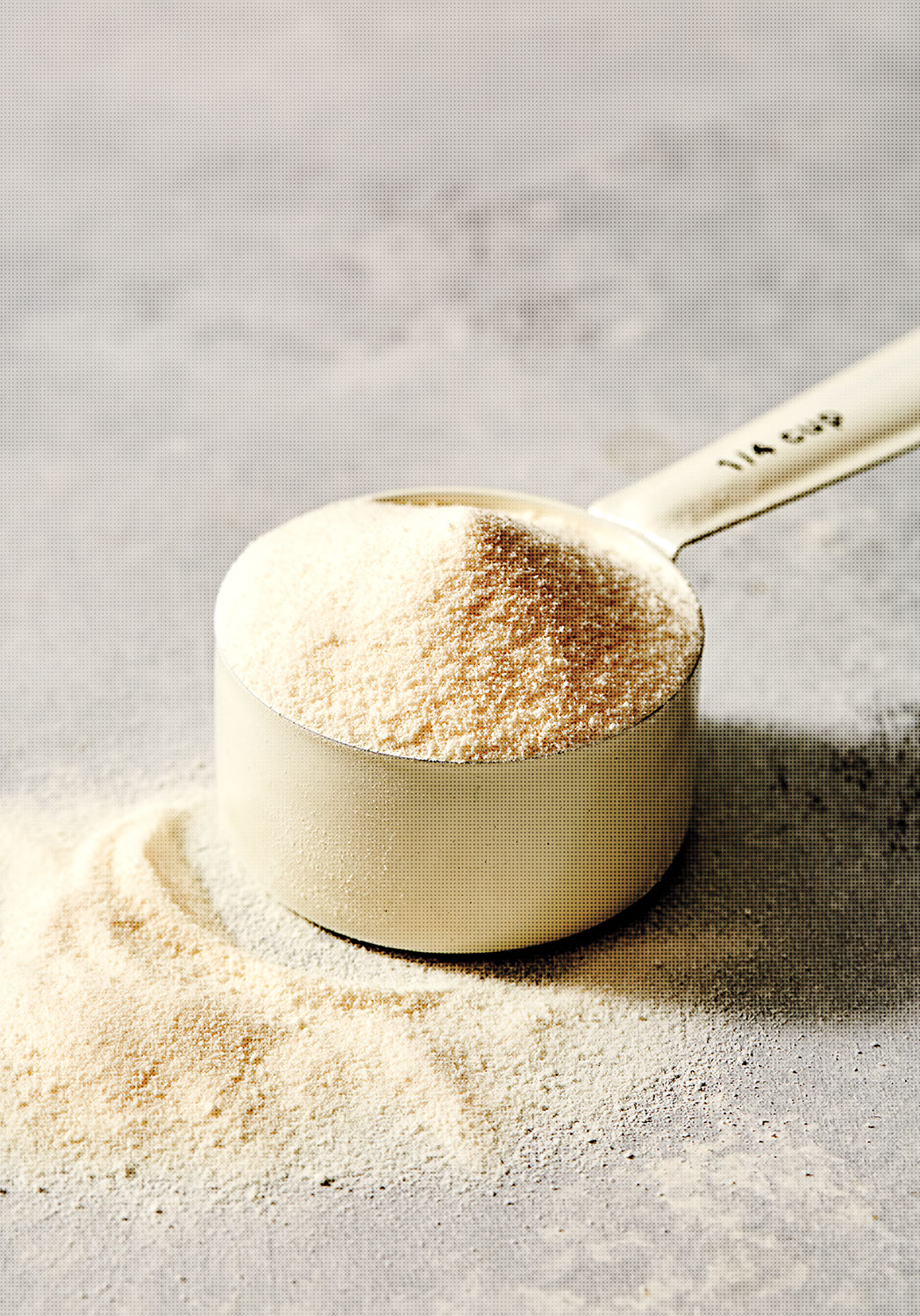
PHOTOGRAPHS BY RIKKI SNYDER ✷ FOOD STYLING BY LESLIE ORLANDINI ✷ RECIPES BY OLIVIA ROSZKOWSKI
There’s a protein in your body—the most abundant one there, in fact—that fortifies your bones, muscles, and tendons. The protein also offers a protective covering for delicate organs like your kidneys. If that weren’t enough, it’s key to keeping your skin taut and youthful looking. The multitasking health superhero? Collagen.
Despite all the benefits, the body’s natural collagen stores are finite. “As early as our twenties, the cells that produce collagen begin to degrade and produce less of it,” says Mark Moyad, M.D., director of preventative and alternative medicine at the University of Michigan. In fact, you can expect to lose about one percent of your body’s natural collagen every year, beginning at age 20. By the time we hit age 40, our bodies are degrading collagen faster than we can produce it.
As a result, you’ll lose the protein’s essential amino acids—proline and lysine, for example—which are used to build muscle, bone, and skin. Logically, then, if you replace your body’s supply of collagen through a pill or powder, you can shore up your stores of these amino acids and stay healthy longer, right?
In some cases—yes. But nothing’s quite that simple. There are more than twelve types of collagen, each comprised of different “peptides,” or amino acids, that focus on distinct functions. (See sidebar on page 66 for a rundown.) In most cases, what you’re buying at the health food store is hydrolyzed type-I collagen, says Moyad.
And vegans take note: Type-I collagen is usually extracted from animal hides and bones or fish scales. Some studies have shown that these animal materials can be sources of dangerous metals like lead, which could put you at risk for related health concerns. “It’s always best to take a supplement that’s been verified by a third-party agency for contaminants,” says Moyad. Most quality collagens are certified by agencies such as the NSF (a food safety agency) and USP (which sets quality and purity standards for supplements). Look for a trusted brand with a third-party label.
Also, shop for companies that get their bones and tissues from cage-free, free-range, and antibiotic-free sources. Be sure to check out the company’s website to see what it’s doing to keep heavy metals and other contaminants out of their products.
The best types will also have a few simple ingredients, including collagen protein isolate, a.k.a. collagen hydrolysate, hydrolyzed collagen, or collagen peptides. Finally, give a sniff test before you add a dose of collagen powder into your recipes: Collagen in powder form should be odorless and colorless. If it has a funny smell or appears yellowish, it could indicate a low-quality collagen.
Once you pick your powder, add a measured scoop to these recipes from our Culinary Editor, Olivia Roszkowski. Chef Olivia has been using the powders regularly. “Overall, I think of it as a fun, added vitamin-like substance that possibly gives the body a boost,” she says. “I honestly do see a difference in my hair and skin health.”
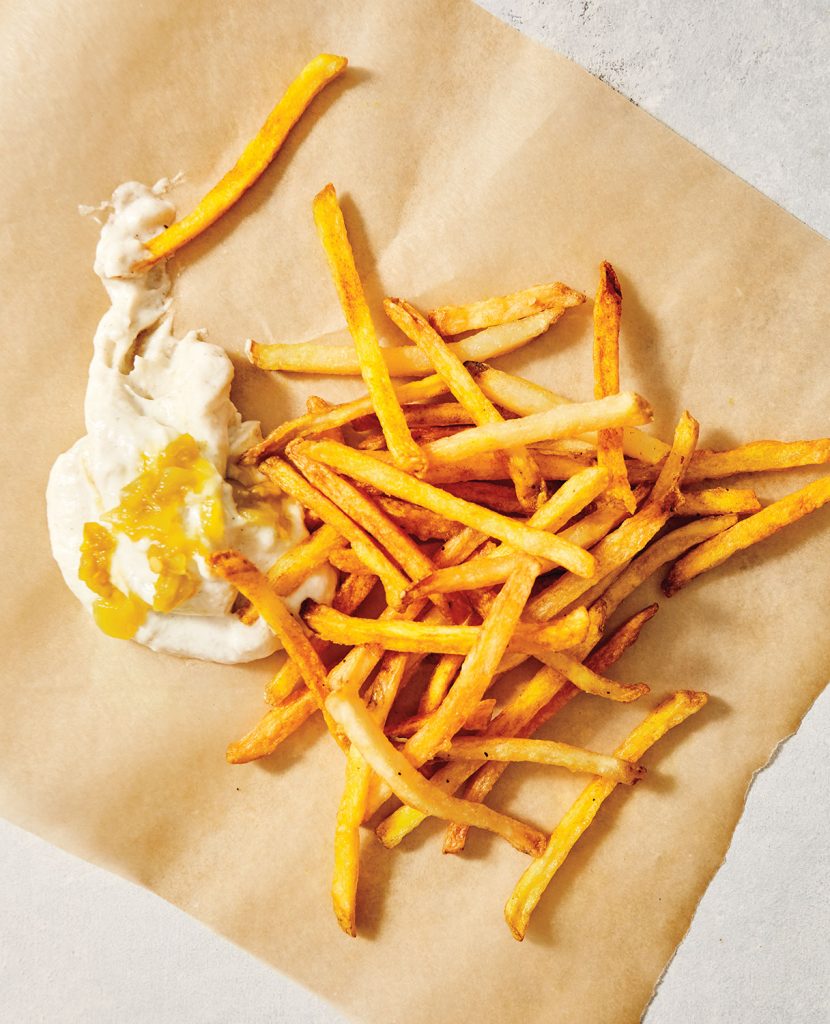
Baked Turmeric Fries With Collagen Hemp ‘Queso Blanco’
Yield: 3 cups fries; 1½ cups ‘Queso Blanco’
FOR QUESO BLANCO
Gather
½ cup hemp hearts
2 tablespoons collagen powder
3 tablespoons organic corn starch
¼ cup refined coconut oil
2 garlic cloves
1 teaspoon apple cider vinegar
1 teaspoon sea salt
1 can diced green chili (4 ounces)
To Make
Soak hemp hearts in 2 cups hot water for ten minutes.
Add hearts to blender along with collagen powder, corn starch, coconut oil, garlic cloves, apple cider vinegar, and sea salt.
Blend until completely smooth on high speed for 30 seconds.
Pour mixture into a pan and bring to a boil.
Cook for 1 minute or until thickened, stirring frequently.
Strain diced green chilis, discarding liquid. Fold diced chilis (approximately ¼ cup) into ‘queso.’ (Note: If you’re using mild chilis, add hot sauce to taste.)
Serve ‘Queso Blanco’ hot over Baked Turmeric Fries.
FOR BAKED TURMERIC FRIES
Gather
3 Russet potatoes (1½ pounds)
½ teaspoon turmeric powder
½ teaspoon ground black pepper
1 teaspoon sea salt
3 tablespoons olive oil
To Make
Preheat oven to 375°F. Line baking tray with parchment paper.
Peel potatoes and cut into long strips that are about 1/4-inch thick.
Place potatoes onto lined tray and gently massage with turmeric powder, ground black pepper, salt, and olive oil.
Bake for 20 to 25 minutes or until crispy and cooked through. Use a silicone spatula to toss the potatoes and redistribute the oil once halfway through the cooking process.
Serve baked turmeric fries hot and drizzled with hot ‘Queso Blanco.’
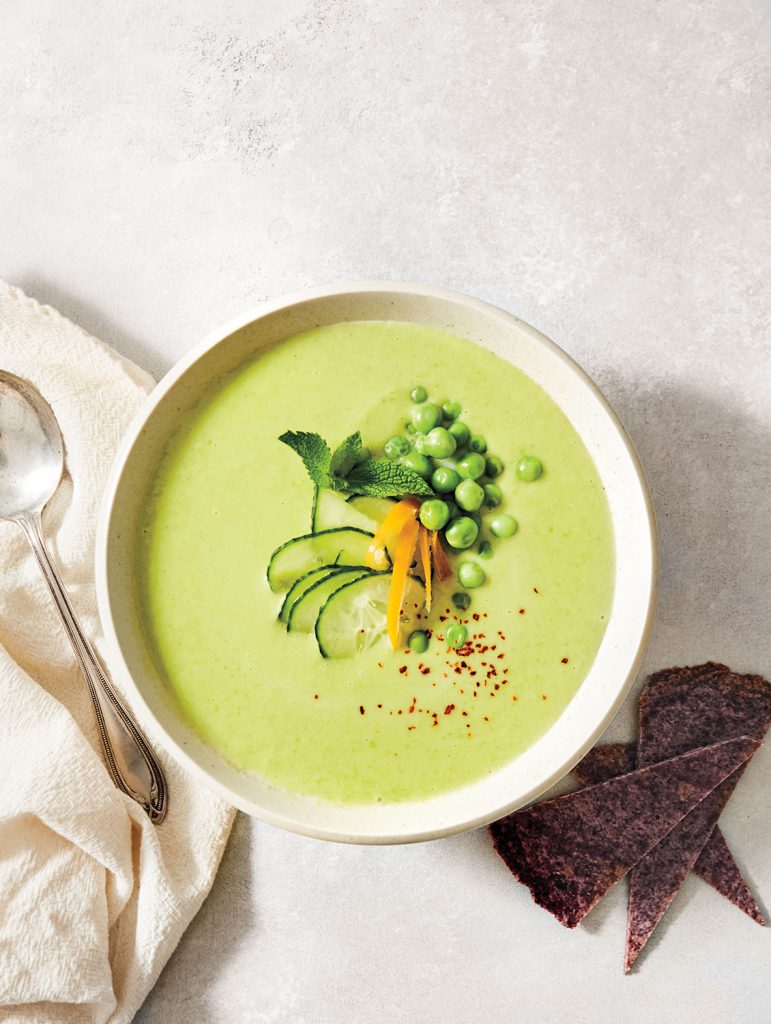
Chilled Collagen Mint Pea Soup with Blue Corn Tortillas
Yield: 4 cups soup; approximately 2 dozen tortilla pieces.
FOR BLUE CORN TORTILLAS
Gather
2 tablespoons avocado oil
1½ cups masa harina (we use Bob’s Red Mill)
2 tablespoons butterfly pea flower powder
1 teaspoon sea salt
¾ cup plain dairy/nondairy yogurt
¼ cup filtered water
To Make
Preheat oven to 450°F. Place baking tray into oven to heat it.
Stir together avocado oil masa harina, butterfly pea powder, and sea salt in a medium bowl.
Fold yogurt and water into flour mix until dough forms.
Cover and allow to rest for 10 minutes.
Roll out dough gently with a rolling pin between two pieces of parchment paper to a ¼-inch thickness.
Leaving rolled-out dough on the parchment sheet, use a knife to cut dough into triangles or desired shapes.
Carefully transfer parchment with cut dough onto preheated baking tray.
Bake for 10 minutes, and transfer onto wired rack to cool.
FOR MINT PEA SOUP
Gather
2 tablespoons spearmint tea leaves
2 tablespoons collagen powder
1 cucumber
2 tablespoons preserved lemons, extra for garnish
2 garlic cloves
1½ cups frozen peas, extra for garnish
½ cup plain dairy/non-dairy yogurt, extra for garnish
1 teaspoon Aleppo pepper, or to taste
To Make
Bring 1 cup of filtered water to a boil. Turn off heat and add mint tea and collagen powder. Brew for 10 minutes. Strain and discard leaves.
Peel, deseed, and chop cucumber (yields approximately 2 cups).
Chop preserved lemon, discarding any seeds.
Mince garlic.
Set aside a small amount of peas, preserved lemon pieces, cut cucumber, and yogurt for garnish.
Add mint tea, cucumber, preserved lemons, garlic, frozen peas and plain yogurt into a blender. Process until smooth.
Pour into bowl and top with reserved peas, preserved lemons, cucumbers, yogurt, and Aleppo pepper. Serve with Blue Corn Tortillas.
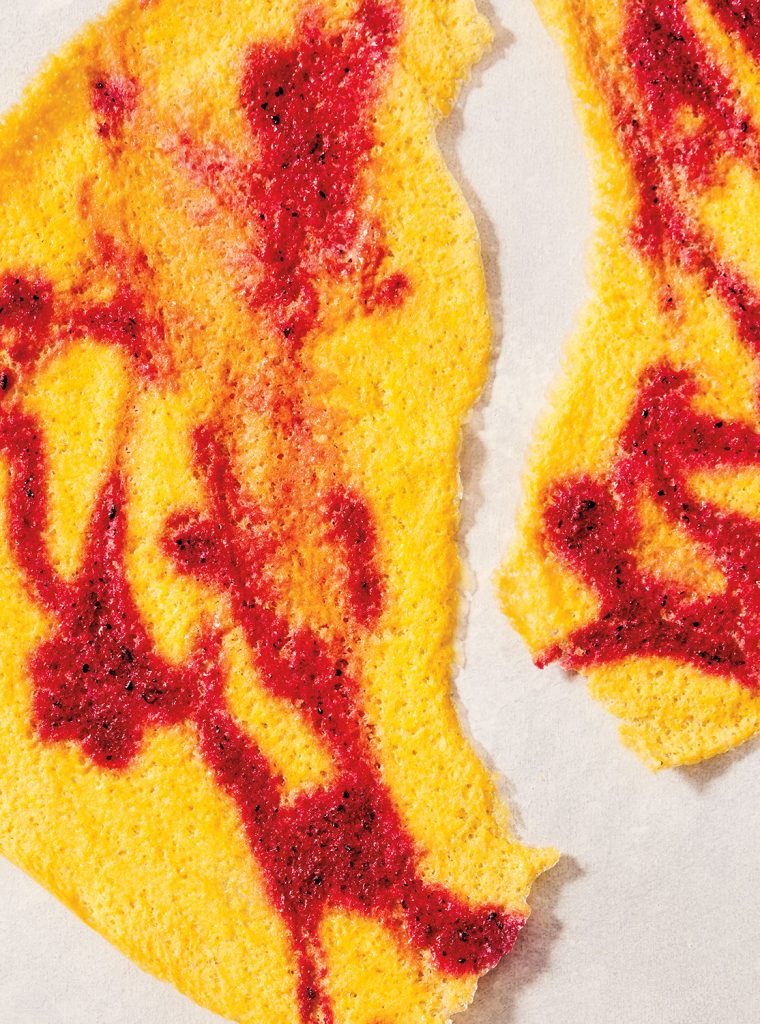
Collagen Marbled Assorted Fruit Leathers
Yield: 3 12-x-12-inch fruit leather sheets
BASE FOR EACH FLAVOR
Gather
2 tablespoons lemon juice
½ cup unsweetened applesauce
2 tablespoons collagen powder
FOR FRUIT VARIATIONS
Gather
1 cup frozen strawberries
1 cup frozen pink dragon fruit
1 cup frozen mango
To Make
Add lemon juice, applesauce, and collagen powder to a blender and process until smooth.
Choose one of the fruit variations, add to blender and process until smooth.
Repeat process with remaining fruit variations.
Line three dehydrator trays with designated nonstick silicone baking mat.
Choose one variation and use offset spatula to spread into a thin layer onto tray, reserving ¼ cup to use as a topcoat for another tray.
Spoon the reserved puree of a varying fruit variation on top in a swirling circle spiral pattern. Drag the back of a spoon to repeatedly form the shape of a number eight to create the marbled effect.
Dehydrate trays for 6 to 8 hours at 130°F, or until fruit leathers easily peel off.
Cut into desired shapes using kitchen shears and enjoy.
If storing for extending amount of time, place onto parchment paper, roll, and secure. Store in airtight container to keep leathers from drying out.
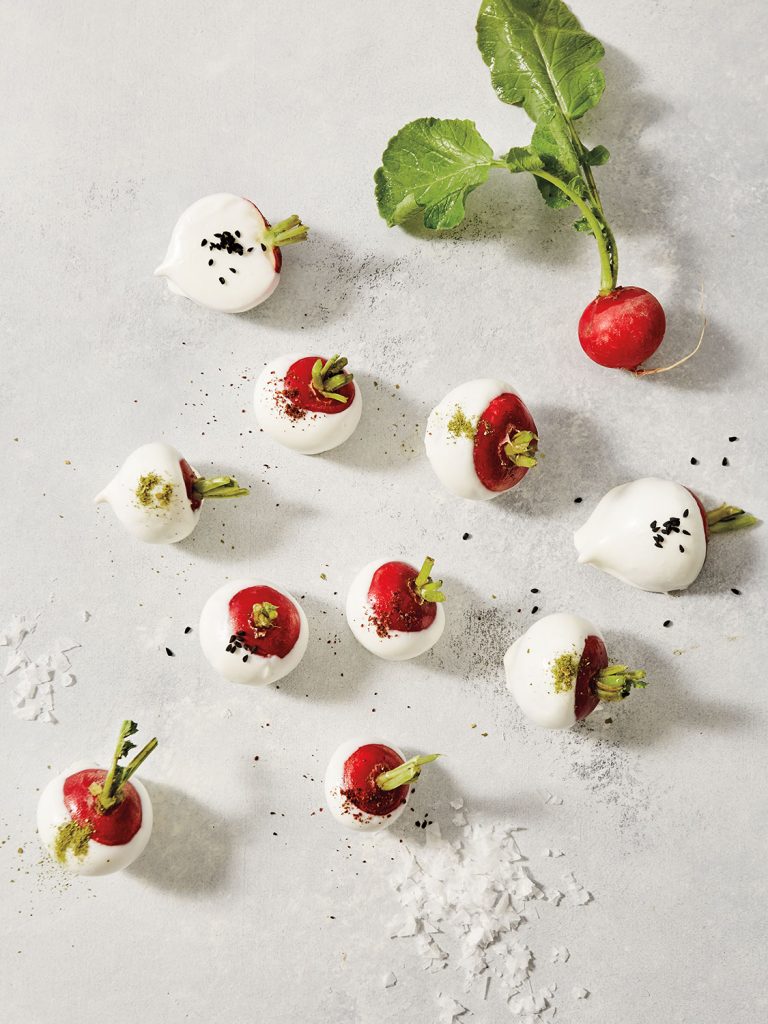
Collagen Cultured Plant ‘Butter’ Dipped Rainbow Radishes with Flaky Salt
Yield: 1 cup ‘butter’; approximately 12 radishes
FOR PLANT ‘BUTTER’
Gather
¾ cup refined coconut oil
1 garlic clove
¼ cup plain vegan yogurt
1 tablespoon unflavored collagen powder
½ teaspoon sea salt
2 bunches rainbow radishes
1 tablespoon dried chives
1 tablespoon nigella seeds
1 tablespoon sumac
1 tablespoon flaky sea salt
To Make
Melt coconut oil in a small pan.
Mince garlic.
Add melted coconut oil, minced garlic, yogurt, collagen powder, and salt to blender and process until smooth.
Wash and trim radishes. Cut larger radishes in half.
Dry radishes completely to help better adhere plant ‘butter.’
Grind dried chives into a coarse powder with a mortar and pestle, blender, food processor or coffee grinder.
Line plate or tray with parchment paper or silicone baking mat.
Dip each radish in prepared plant ‘butter’ and place on lined surface. Sprinkle with either chives, nigella seeds, or sumac. Top with flaky salt.
Repeat process with remaining radishes, and place in refrigerator for 20 minutes to set.
Keep radishes refrigerated until ready to serve.

Fava Bean Pesto & Chili-Marinated Asparagus Plantain Crust Pizza
Yield: 1 large pizza
FOR FAVA BEAN PESTO
Gather
1 cup fava beans (can substitute frozen lima beans or edamame), plus extra for garnish
3 garlic cloves
3 tablespoons fresh thyme leaves, extra for garnish
1/3 cup olive oil
1 teaspoon sea salt
½ cup hulled pumpkin seeds
2 tablespoons preserved lemons, extra for garnish
2 tablespoons white miso
To Make
If using frozen beans, place in strainer and pour over cold water until defrosted.
Smash garlic and place in pan, along with fresh thyme, olive oil, sea salt, and pumpkin seeds.
Bring mixture to a simmer over medium-low heat and cook for 2 to 3 minutes, or until pumpkin seeds color slightly.
Chop preserved lemons, discarding any seeds.
Add fava beans, pumpkin seed mixture, chopped preserved lemons, miso and 1/3 cup filtered water to a food processor. Process for 1 minute, or until mixture resembles a coarse paste.
FOR CHILI-MARINATED ASPARAGUS
Gather
1 bunch asparagus
2 tablespoons olive oil
½ teaspoon sea salt
1 tablespoon harissa paste, extra for garnish
To Make
Cut asparagus into 2-inch pieces, discarding ends.
Add asparagus pieces to pan along with olive oil, sea salt, and harissa paste.
Warm mixture over medium heat and cook for 2 minutes.
FOR PLANTAIN CRUST
Gather
2 cans chickpeas
1/3 cup avocado oil, extra to grease tray
1¼ cups plantain flour
1 teaspoon baking powder
2 teaspoons garlic powder
2 teaspoons dried oregano
2 tablespoons collagen powder
1 teaspoon sea salt
To Make
Preheat oven to 450°F. Place baking tray in oven to preheat for 10 minutes.
Drain and rinse chickpeas (approximately 3½ cups).
Add to blender along with avocado oil and ½ cup filtered water.
Blend for 30 seconds on high, or until completely smooth.
In a medium bowl, mix together plantain flour, baking powder, garlic powder, dried oregano, collagen powder, and sea salt. Fold in chickpea mixture, working dough until it is firm.
Grease parchment paper with avocado oil.
Using hands, press dough onto greased paper into a ¼-inch-thick circle.
Use a knife to score slices.
Use a fork to poke holes throughout crust, avoiding outer border.
Transfer dough with parchment carefully onto the heated tray.
Bake for 25 to 30 minutes. If a crispier crust is desired, transfer dough slices onto a wired rack, brush with oil and continue to cook for 10 to 15 minutes.
When ready to serve, top Plantain Crust with Fava Bean Pesto and Chili-Marinated Asparagus. Garnish with reserved fava beans, thyme leaves, preserved lemons, and harissa paste.
Serve warm or at room temperature.

Roasted Cabbage Wedges with Coconut ‘Bacon Bits’ & Creamy Sunflower Dressing
Yield: 8 wedges; 1¾ cups dressing; 2 cups ‘bacon bits’
FOR CABBAGE WEDGES
Gather
2 tablespoons sea salt
1 head green cabbage
1 head purple cabbage
½ cup olive oil
¼ teaspoon freshly ground pepper
To Make
Preheat oven to 450° F. Place baking tray in oven to heat up.
Bring a medium pot filled halfway with water to a boil and add sea salt.
Cut cabbages into quarters to form wedges, removing any wilted leaves and cutting away some of the tough core.
Boil green cabbage for 5 minutes, remove, and proceed to boil purple cabbage for 5 minutes in the same pot. Place boiled cabbage onto wired rack to remove excess moisture, blotting dry with a towel if necessary.
Once cool enough to handle, rub wedges generously with olive oil, loosening the layers to help distribute the oil within. Sprinkle with black pepper.
Carefully lay wedges in a single layer on hot baking tray and cook for 30 minutes or until crispy. Or grill until crispy.
FOR COCONUT ‘BACON BITS’
Gather
2 tablespoons maple syrup
2 tablespoons olive oil
1 tablespoon liquid smoke
2 tablespoons tamari
2 cups large unsweetened coconut flakes
To Make
Preheat oven to 300° F. Line baking tray with parchment paper.
In a medium bowl, whisk together maple syrup, olive oil, liquid smoke, and tamari.
Add in coconut flakes and fold to incorporate the marinade. Allow to marinate for 5 minutes.
Spread coconut flakes onto lined tray and bake for 15 minutes. Toss and continue to bake for additional 5 minutes, or until the flakes are golden and glossy.
FOR SUNFLOWER DRESSING
Gather
1 head garlic
½ cup avocado oil
1/3 cup roasted sunflower seed butter
2 tablespoons unflavored collagen powder
1 teaspoon sea salt
1 cup filtered water
1 bunch chives, for serving
To Make
Peel garlic and cut cloves in half. Place in a small pan. Cover with avocado oil and cook on low heat for 15 to 20 minutes, or until garlic softens and is lightly golden.
Cool mixture slightly and place in blender with sunflower seed butter, collagen powder, sea salt, and filtered water. Process until smooth.
Thinly slice chives.
Arrange roasted cabbage wedges on serving plates and spoon over sunflower dressing.
Garnish with coconut ‘bacon bits’ and cut chives.



